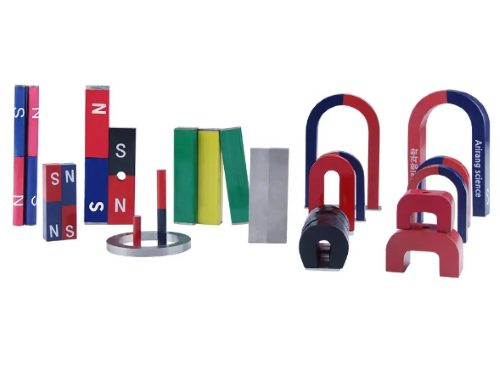Types and Uses of Alnico Magnets
Introduction
Alnico magnets, composed primarily of aluminum, nickel, cobalt, and iron, are renowned for their exceptional magnetic properties and stability across various temperatures. Developed in the 1930s, these permanent magnets have become a crucial component in many applications due to their unique characteristics. This article will explore the different types of alnico magnets and their wide-ranging uses in everyday life and industrial applications.

Types of Alnico Magnets
Alnico magnets are available in several types, each with distinct properties tailored for specific applications. The most common types include:
1. Cast Alnico Magnets
Cast alnico magnets are produced through a casting process, allowing for the creation of complex shapes. This method enables manufacturers to design magnets tailored to specific applications, making them ideal for industrial and specialized uses. Cast alnico magnets typically exhibit high magnetic strength and stability, making them suitable for high-temperature environments.
Related reading: Types and Uses of Permanent Magnet
2. Sintered Alnico Magnets
Sintered alnico magnets are made by compacting powdered metal and then sintering (heating without melting) the material to form a solid magnet. This process results in a denser and more uniform structure compared to cast magnets, providing enhanced magnetic performance. Sintered alnico magnets are often used in applications requiring precise magnetic properties.
3. Alnico V Magnets
Alnico V magnets are one of the most popular types of alnico magnets, characterized by their high strength and excellent temperature stability. The composition includes a higher percentage of nickel and cobalt, making them particularly effective in various applications, including electric guitar pickups and high-performance motors.
4. Alnico II Magnets
Alnico II magnets have a slightly lower magnetic strength compared to Alnico V, but they possess a better magnetic field stability. This makes them suitable for applications where a softer magnetic field is required, such as in specific types of sensors and instruments.
5. Alnico III and IV Magnets
Alnico III and IV magnets are less commonly used but still have specific applications. They are designed for specialized fields, such as certain types of electric motors and sensors, where their unique magnetic properties can be beneficial.
Uses of Alnico Magnets
The versatility of alnico magnets allows them to be utilized in a wide array of applications across various industries. Here are some of the most common uses:
1. Electric Motors
Alnico magnets are widely used in electric motors, where they provide the necessary magnetic field for efficient operation. These magnets are especially favored in small motors found in household appliances, tools, and fans. Their durability ensures that the motors function effectively over extended periods.
2. Guitar Pickups
One of the most celebrated uses of alnico magnets is in electric guitar pickups. Alnico V magnets, in particular, are prized for their ability to produce warm and rich tones, contributing to the overall sound quality of the instrument. Guitarists often prefer alnico magnets for their tonal characteristics, making them a staple in high-quality pickups.
3. Magnetic Sensors
Alnico magnets are employed in various types of magnetic sensors, which are essential for detecting the presence and strength of magnetic fields. These sensors are used in applications ranging from security systems (door and window sensors) to automotive systems (speed sensors and position sensors), enhancing safety and functionality.
4. Industrial Applications
In industrial settings, alnico magnets find numerous applications. They are commonly used in relays, solenoids, and electromagnetic switches, where strong magnetic fields are required for reliable operation. Their high-temperature stability makes them suitable for harsh environments, ensuring consistent performance in industrial machinery.
5. Magnetic Holders and Clamps
Alnico magnets are often incorporated into magnetic holders and clamps used in workshops and manufacturing environments. These devices securely hold tools and materials in place, allowing workers to focus on their tasks without the risk of slips or falls. Alnico’s strength makes these holders highly effective.
6. Navigation Compasses
Due to their stable magnetic properties, alnico magnets are used in navigation compasses. These compasses provide accurate directional readings, essential for hiking, sailing, and other outdoor activities. The reliability of alnico in various environmental conditions ensures users can depend on their compasses for guidance.
7. Toys and Educational Kits
Alnico magnets are frequently found in toys and educational kits designed to teach children about magnetism. Magnetic building sets, puzzles, and science kits leverage the properties of alnico magnets to create engaging learning experiences, allowing kids to explore fundamental scientific concepts in a fun way.
8. Research Applications
In scientific research, alnico magnets are utilized for various experimental purposes. They are employed in magnetic resonance imaging (MRI) machines and other laboratory equipment, where their stability and strength are crucial for obtaining accurate results. Researchers also use alnico magnets to study magnetic fields and their effects on different materials.
Conclusion
Alnico magnets play an essential role in many aspects of modern life, including electric motors, guitar pickups, and scientific research. As technology advances, the demand for these remarkable magnets is likely to grow, ensuring their presence in various innovative applications for years to come. For more types of magnet products, please check Stanford Magnets.














